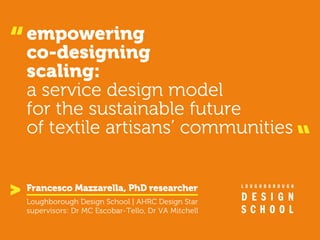Empowering, Co-designing, Scaling: A Service Design Model for the Sustainable Future of Textile Artisans' Communities
The global economic and environmental crisis is creating momentum for designers to challenge the current “linear economy” based on a take-make-waste model, and explore sustainable strategies, services and systems. Within this arena, textile artisanship is becoming an interesting opportunity for opening up micro-enterprises, addressing the complex challenges posed by future trends (e.g. slow consumption, alternative economies, redistributed manufacturing, flexible production, circular economy, advanced artisanship, design entrepreneurship and enabling ecosystems). In particular, this research is focused on textile artisans’ communities, bottom-up and human-centred aggregations engaged in giving form and meaning to local natural fibres, by hands or by directly controlling mechanised and digital tools, and managing the process of making culturally and socially significant apparel. With this in mind, a theoretical framework has been developed, outlining barriers, enablers and a sustainable manifesto for textile artisans’ communities. Service design is here proposed as a key approach within this scenario, due to its user-centric, relational and systemic strength to co-create tangible and intangible value towards holistic sustainability. Using service design methods, participatory action research is pursued to empower artisans’ communities, co-design collaborative services and scale up innovations within an enabling ecosystem. The overall aim of this research is to explore how service design can encourage textile artisans’ communities towards a sustainable future, providing social engagement, rescuing cultural heritage, boosting economic development and enhancing environmental stewardship.

Recommended
Recommended
More Related Content
Similar to Empowering, Co-designing, Scaling: A Service Design Model for the Sustainable Future of Textile Artisans' Communities
Similar to Empowering, Co-designing, Scaling: A Service Design Model for the Sustainable Future of Textile Artisans' Communities (20)
Recently uploaded
Recently uploaded (20)
Empowering, Co-designing, Scaling: A Service Design Model for the Sustainable Future of Textile Artisans' Communities
- 1. empowering co-designing scaling: a service design model for the sustainable future of textile artisans’ communities Loughborough Design School | AHRC Design Star supervisors: Dr MC Escobar-Tello, Dr VA Mitchell Francesco Mazzarella, PhD researcher
- 3. research problem the global economic and environmental crisis is posing complex challenges
- 6. to explore how service design can contribute to encourage textile artisans’ communities towards a sustainable future aim
- 7. scope material by hands machinery digital tools bottom-up skills, quality human control material culture local, natural discarded fibres textiles & fashion artisan community local business small batches flexible local market tool making
- 8. PAR methodology 2A act sustainable future trends for TAC reflect barriers, enablers, sustainable manifesto plan map TAC & future trends plan sampling strategy, study protocol, pilot reflect impact of service design model 2Cto develop theoretical framework for sustainable future for TAC conclusions & discussion to develop flexible service design model of co-designing collaborative services for sustainable TAC to empower TAC to co-design a collaborative serviceto scale up innovations within enabling ecosystem 1B 1C 1A main studies evaluation scoping study 2B act sustainable future trends for TAC TAC: textile artisans’ communities
- 9. service design methodsdiscover define develop deliver focus group interviews shadowing contextual interviews brainstorming participatory design workshop stakeholders map ecosystem canvas servive blueprint user centred, relational, systemic process of co-creation of tangible and intangible values to encourage holistic sustainability
- 10. challenging sustainable futuresdiscover focus group interviews shadowing experts’ focus group shadowing semi-structured interviews
- 11. theoretical framework a sustainable manifesto for textile artisans’ communities Shift the focus from aesthetics to ethics, from style to quality meanings; Ethical labour and rights must be set: less bad is not good; Textile artisanship stands as a slow reaction to fast fashion; Textiles are interconnected to their wholeness: materials, processes, people, places; Being vs. having, learning from nature and acknowledging the unpredictable; Manage connectivity within local communities, as collective wisdom and social act of collaboration; Design as political agent, embracing diversity as resource, weaving synergies among different assets; Scale up open initiatives within peer-to-peer networks at a glocal scale; Understand the root system and trigger holistic and systemic change, from micro to macro scales; Build an enabling ecosystem: complex, adaptive infrastructure supported by polycentric governance. barriers enablers Dominance of financial structures based on profits; Lack of time & efforts to develop alternative models; Lack of skills; Export of machinery and outsource of production; Lack of interest for young people in craft production; Endangered craft heritage; Consumers’ misperception of quality; Over-consumption; Lack of information on textiles, artisans and sustainability challenges; Lack of sustainability uptake; Lack of training in strategies/management/ entrepreneurship in design curricula. Change of mindset (systemic thinking); Interconnected design-artisanship-academia -policy-consumers; Cultural empathy with artisans; Metatools, flexible, collaborative, reflective; Storytelling to elicit and convey engaging meanings; Empowerment models: access to information, awareness, ability, independency; Development of sustainable business models; Technological advancements.
- 12. PAR strategy participatory action research to develop a flexible service design model of co-designing collaborative services, encouraging textile artisans’ communities towards a sustainable future new york cape town nottingham to empower a heritage artisans’ community to scale up a cutting-edge artisans’ ecosystem to co-design with contemporary artisans
- 13. storytelling with nottingham lace artisansdefine contextual interviews brainstorming Kula Tsurdiu bridal dresses leavers lace shawls knitting lace jewellery embroidered lace G H Hurt & Son Ltd JC Middlebrook
- 14. initial findings g h hurt & son ltd storytelling with nottingham lace artisans photo-diaries SWOT analysis of ideas challenges & opportunities to move towards a sustainable future
- 15. next... community develop deliver participatory design workshop stakeholders map ecosystem canvas servive blueprint 1 day participatory design workshop: co-designing a sustainable future for nottingham lace artisans organisatio ns design ers consumers
- 16. textile artisans’ communities can contribute to a sustainable development rescue cultural heritage provide social engagement encourage economic development enhance environmental stewardship
